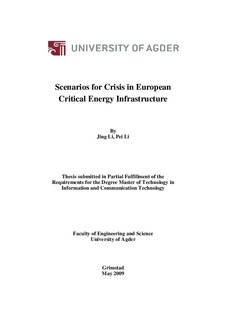| dc.description.abstract | A sudden crisis occurrence, such as a big electricity cut, might not be regarded as an
isolated incident: In almost all cases, a power outage crisis might bring about multiple
losses with e.g. legal, social and economic aspects: Owing to interdependencies,
failures in grid nodes might propagate asynchronously, resulting in a compounded
disruption by cascading effects1, potentially leading to a societal catastrophe. So this
is why crisis management has key importance in contemporary society. A proper
scenario planning and its evaluation result should be regarded as an efficient and
valuable approach to help Society prevent crisis occurrence and, if crisis strikes,
mitigate the consequential losses.
This master project is a sub-task of EU (European Union) crisis management project.
As a matter of fact this EU project is to identify some relevant scenarios of power cut
crisis that might happen. By investigating them, provide a prototype model of virtual
crisis scenario frame as well as simulation results. According to the research of crisis
scenarios and simulation work, we make clear how to improve the crisis management
so that it could mitigate cascading faults, and improve the system’s resilience by
reasonable resources allocation.
As the student researchers in this project, we propose an approach to quantify
essential details of impacts, causalities and developmental sequences. Making use of
general dynamic analysis software Vensim {Ventana Systems, Vensim Software -
Linking system thinking to powerful dynamic models} to simulate whole process
based on our analysis to relevant scenarios of power cut crisis. A virtual generic
scenario regarding power outage which based on the research results was created in
our project, and this virtual scenario prototype was evolved from the 2003 Denmark
and Sweden power outage. The creation of virtual scenario is based on the research of
the relevant scenario planning approaches, and the system dynamics knowledge was
used as methodology to guide us achieving the conceptual modeling works. Actually
our model is a simplified minimum conceptual model which focuses on the arguably
central aspects of crisis management such as cascading faults, resources allocation etc.
The results of simulation verified the importance of crisis management in terms of the
lifecycle and presented dynamic behaviors in three distinct runs that are run
“Equilibrium”, run “Attack” and run “Resource deficiency”. | en |
